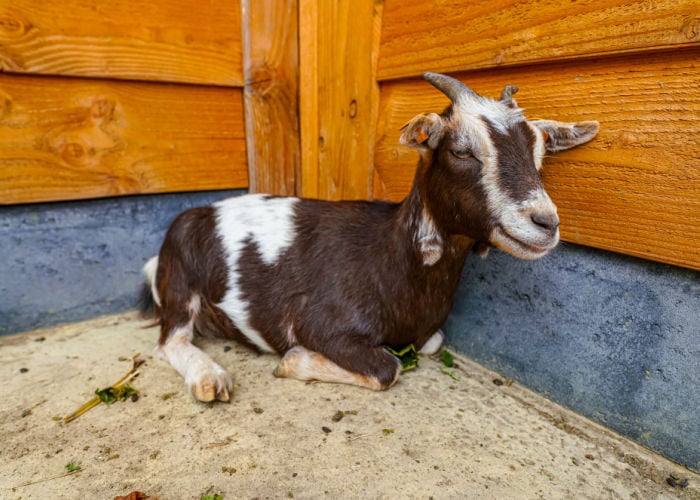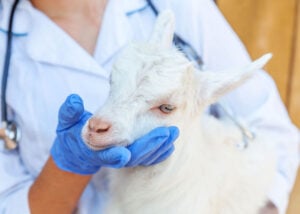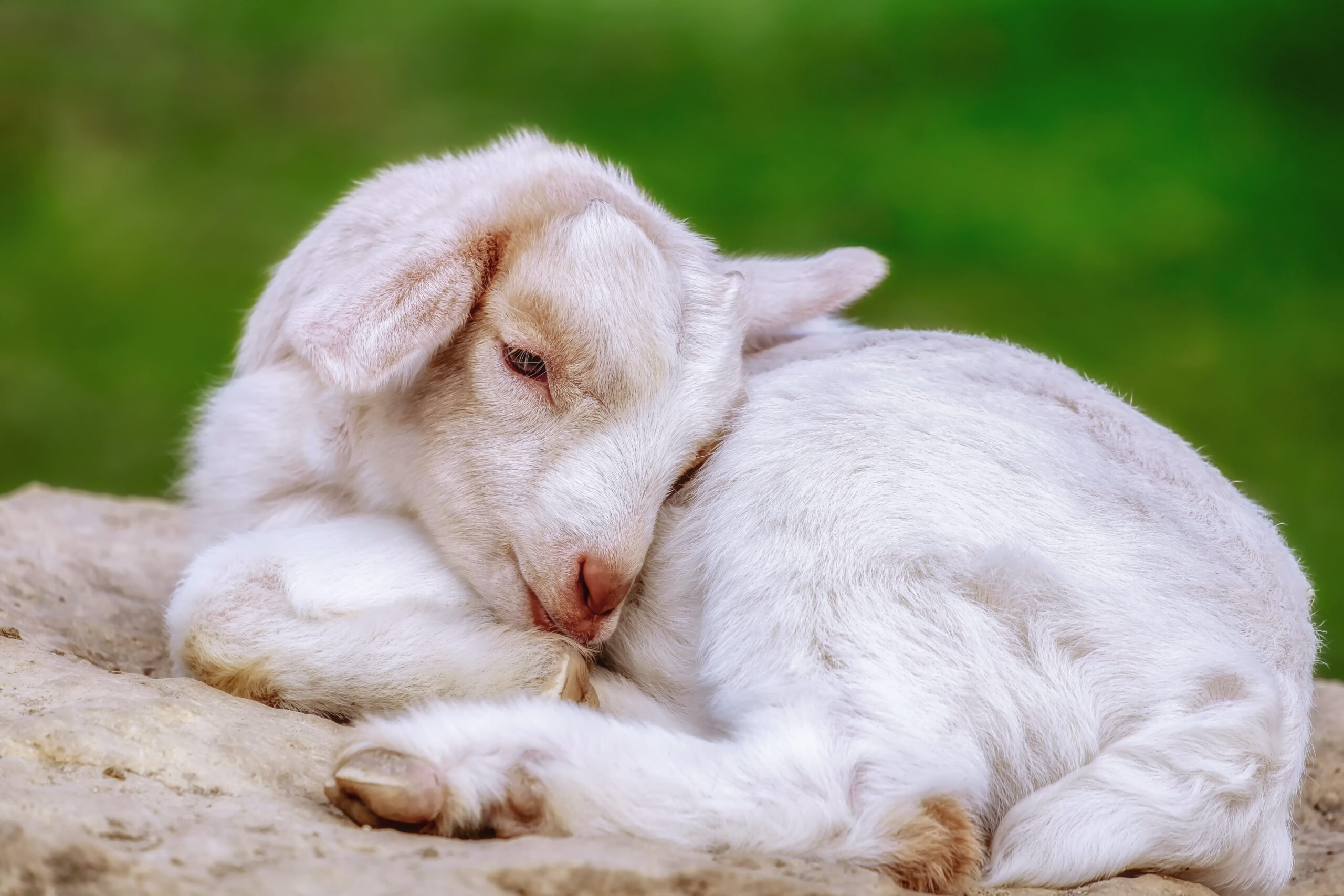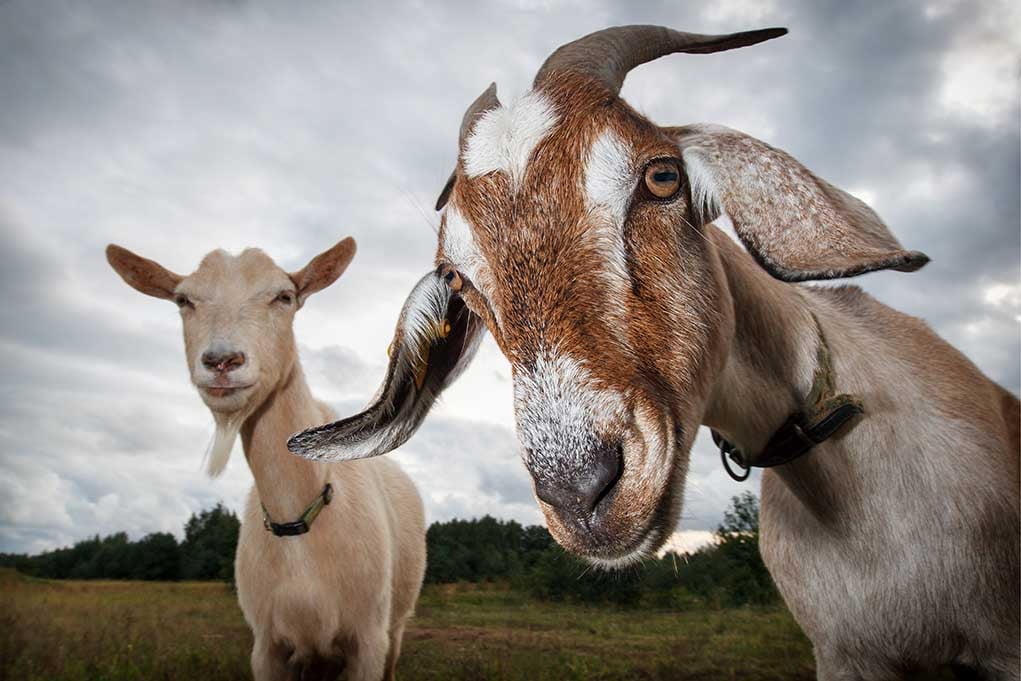If your sick goat won’t get back up, you’ve got to act fast to save them.
I understand that it’s scary having a goat who is down and refuses to stand back up.
So in this article, I’ll cover the most common issues that would cause a sick goat to lie down and not stand back up again, plus how you can help them get better as quickly as possible.
Common Issues Why Sick Goat Won’t Get Up
Goat Polio
Goat polio, also known aspolioencephalomalaciaor cerebrocortical necrosis, is a neurological disorder that affects goats.
It is not related to the polio virus that affects humans.
Goat polio is primarily caused by a thiamine (vitamin B1) deficiency in the goat’s diet.
Thiamineis vital to the goat’s metabolism and nervous system functions.
Several factors can lead to thiamine deficiency and the subsequent development of goat polio.
One common cause is a sudden change in diet, particularly a switch from a forage-based diet to a high-concentrate or grain-based diet.
This sudden dietary change can disrupt the goat’s digestive system and inhibit the production and absorption of thiamine.
Other factors contributing to thiamine deficiency include ingesting thiaminase-containing plants, certain feed contaminants, or thiamine-destroying bacteria in the rumen.
Signs & Treatment of Goat Polio
Recognizing the symptoms of goat polio is crucial for early intervention.
Affected goats may exhibit a range of neurological signs such as ataxia (uncoordinated movements), head pressing, blindness, circling, seizures, and overall depression.
If left untreated, goat polio can lead to coma and death.
If you suspect a goat has polio, it is essential to seek veterinary assistance immediately.
A veterinarian will likely diagnose the condition based on clinical signs and may perform additional tests to confirm the thiamine deficiency.
Treatment for goat polio primarily involves administering thiamine injections right away.
Thiamine supplements can be given orally, intravenously, or directly into the muscle.
It is essential to work closely with a veterinarian to determine the appropriate dosage and frequency of thiamine administration.
In addition to thiamine supplementation, supportive care is crucial for the goat’s recovery.
This includes providing a quiet, stress-free environment, ensuring access to fresh water, and offering high-quality forage or hay.
Providing a slurry of pelleted feed or soaked hay may be necessary if the goat has difficulty eating or swallowing.
I’ve found that using a food processor is the fastest and easiest way, but a blender or even a pair of scissors or a grinder can do the trick.
Preventing goat polio is key to avoiding this debilitating condition. Plus, prevention is considerably easier than treatment.
So to prevent thiamine deficiency, maintain a consistent and balanced diet for goats.
Gradually allow the rumen to adapt when introducing new feeds or making dietary changes.
Ensure constant access to thiamine-rich sources, such as good-quality forage, leafy greens, and thiamine-fortified feeds.
Dehydration
The goat’srumen is 40 to 70% water, depending on the animal’s age.
Because of this, dehydration is a serious issue that immediately affects the entire digestive system right away.
Water is crucial for maintaining proper hydration, regulating body temperature, transporting nutrients, and eliminating waste products.
Without sufficient water intake, a goat’s body begins to experience serious imbalances and struggles to perform essential physiological processes.
The goat’s energy levels decline as dehydration progresses, and its muscles can become weak and fatigued.
This weakness can make it difficult for the goat to maintain an upright position and may result in them lying down and unable to stand back up without assistance.
Dehydration is a serious condition that requires immediate attention to stop long-term damage or death.
Pneumonia
Pneumonia is a respiratory infection that can severely affect goats, potentially leading to them lying down and unable to stand again.
When a goat contracts pneumonia, the infection causes inflammation and fluid buildup in its lungs, making it difficult for them to breathe properly.
As a result, their oxygen intake decreases, leading to fatigue and weakness.
Wet weather, a damp barn, high humidity, or harsh changes between hot daytime and cool evening temperature fluctuations usually bring on pneumonia.
Goats with pneumonia may experience reduced energy levels, labored breathing, coughing, and a loss of appetite.
The combination of respiratory distress and weakened muscles can cause a goat to lie down and struggle to stand back up.
Be sure to read our comprehensiveguide to handling pneumonia in goatsfor more information.
Listeriosis
Listeriosis is a serious bacterial infection that can affect goats, leading to significant health issues.
The infection is caused by the bacteriumListeria monocytogenes, which is commonly found in the environment, including soil, water, and decaying vegetation.
Moldy feed is usually the culprit here.
当山羊摄取的细菌污染d feed or water, it can enter their bloodstream and affect the central nervous system.
Listeriosiscan lead to neurological symptoms such as depression, lethargy, loss of coordination, and muscle weakness.
As the infection progresses, goats may find it increasingly difficult to maintain an upright position and may ultimately lay down and struggle to rise.
Prompt veterinary intervention is necessary to treat listeriosis, typically involving antibiotics and supportive care to control the infection and manage neurological symptoms.
It is important to prevent listeriosis by practicing good hygiene, providing clean and uncontaminated feed and water sources, and promptly addressing any signs of illness in goats.
这不容易,但是你最好确保你的果阿ts aren’t jumping into your feed troughs or hay managers– they will dirty and ruin their feed.
Unhealthy Rumen / Bloat
In addition to dehydration, an unhealthy rumen can contribute to a goat’s inability to stand up when sick.
The rumen, a crucial part of the goat’s digestive system, is vital in effectively breaking down roughage.
Without the preparation done by rumen microorganisms, the digestive enzymes in the abomasum and small intestine cannot properly process roughage.
Therefore, maintaining a healthy rumen is essential for a goat’s overall well-being and growth.
Various factors can affect the health of a goat’s rumen, including improper feeding practices, pathogenic bacterial toxins, and oral antibiotics.
Signs of an unhealthy rumen may include decreased appetite, reduced feeding, and inactivity.
Bloatis sadly a common issue where the rumen becomes filled with excess gas due to an inability to release it properly.
Certain diets, such as fresh, green alfalfa, excess grass, or excess grains, can contribute to the formation of trapped gas bubbles in the rumen fluid, leading to frothy bloat.
If not treated promptly, bloat can cause the goat’s rumen to swell, resulting in visible discomfort characterized by kicking, grunting, and slobbering.
The goat may attempt to stand up but ultimately cannot do so.
Unfortunately, if appropriate treatment is not administered in time, the goat’s condition can worsen, potentially leading to fatality.
Baking sodahas been proven to prevent and treat bloat to a degree, but it is not a perfect fail-safe.
Feed your goats a healthy diet of brush, forest forage, brambles, and native herbaceous perennials (aka weeds) whenever possible.
Anemia
Anemia, a condition characterized by a decrease in red blood cells or hemoglobin levels, will significantly impact a goat’s ability to be active.
Red blood cells are crucial in delivering oxygen to tissues throughout the body, including the muscles.
When a goat is anemic, the reduced oxygen-carrying capacity of the blood can result in weakness, fatigue, and a lack of energy.
Anemia in goats可以由多种因素引起的,比如乐趣nal deficiencies,internal parasites, fleas, ticks (guineas can help), or diseases affecting the bone marrow or red blood cell production.
The best way to check for anemia is to gently pull down on your goat’s eyelid to look at the coloring.
A healthy inner eyelid will be bright pink to red; an unhealthy one is pale pink or white.
Malnourishment or Deficiencies
Technically goat polio is a thiamine (Vitamin B1) deficiency.
But it’s not the only deficiency that would cause a goat to lie down and not get back up again.
Here are some others to be aware of:
- Vitamin A.Offer loose minerals to prevent this; injections and pastes of Vitamin A are available for emergencies.
- Other Vitamin Bs.B1 is the most common issue, followed by B12.
- Vitamin E.This one comes out of nowhere and can lead to sudden death, heart failure, White Muscle Disease, and the inability to stand, among other issues.
- Vitamin D.Often called “rickets,” this is best treated by sunshine. It’s most likely to occur in the winter when your goats would rather stand inside where it’s warm.
- Selenium.Selenium deficiencies are common across the US, especially inthese locations. If your area is deficient, you’ll need to supplement.
- Zinc.Zinc deficiency is more likely to affect bucks and wethers, rather than does. Usually, too muchalfalfais the root cause. Use zinc supplements to remedy the deficiency.
Hoof Abscesses or Other Problems
A hoof abscess or otherhoof problemscan significantly impact a goat’s ability to stand up and may result in them lying down and struggling to get back up.
脓肿时细菌进入蹄,作为原因的ing infection and the accumulation of pus within the hoof capsule.
The infection leads to pain and inflammation, making it uncomfortable for the goat to bear weight on the affected hoof.
The goat may choose to lie down to alleviate the pressure and reduce pain.
Other hoof problems such as laminitis, foot rot, or injuries can also cause severe discomfort and lameness, making it difficult for the goat to stand up and walk.
These conditions affect the structural integrity and function of the hoof, leading to pain and reduced mobility.
It is crucial to address hoof abscesses and other hoof problems promptly.
A goat who is lying down is losing muscle and probably suffering from dehydration and eventually malnutrition too.
It’s easy for the issues to snowball into much bigger problems (very quickly too).
Treatment may involve hoof trimming, poultices, antibiotics, pain relief medication, or other interventions based on the specific condition.
Proper hoof care, regular trimming, maintaining clean and dry living conditions, and monitoring the goat’s hoof health can help prevent the occurrence of hoof problems and reduce the likelihood of them becoming debilitating for the goat.
Do your best to provide clean and dry places for your goats, especially in areas they frequent, like hay managers, water troughs, and bedding areas.
Giving your goats boulders, concrete, or other hard surfaces to walk on will help them keep their hooves naturally trimmed and strong.
Sick Goats Won’t Get Up: FAQs
What are some signs that a goat is seriously ill?
Some signs that a goat is seriously ill include lethargy, loss of appetite, weight loss, diarrhea or constipation, difficulty breathing, coughing, discharge from the eyes or nose, and a lack of coordination or inability to stand.
Are there any supplements or treatments that can help a sick goat regain its strength and ability to stand?
There are several supplements and treatments that can help a sick goat regain its strength and ability to stand, including electrolyte solutions, probiotics, vitamin B12 injections, and deworming medications.
However, it’s important to consult with a veterinarian before administering any treatments to a sick goat.
What should you do if a goat is unable to stand for an extended period of time?
If a goat is unable to stand for an extended period of time, it’s important to provide them with a comfortable and clean area to rest, and to monitor their condition closely.
It’s also important to consult with a veterinarian to determine the underlying cause of the goat’s inability to stand and to develop an appropriate treatment plan.
How long can a sick goat go without standing before it becomes a serious issue?
The length of time that a sick goat can go without standing before it becomes a serious issue depends on the underlying cause of the goat’s condition.
In some cases, a goat may be able to recover within a few days with proper treatment, while in other cases, it may take several weeks or even months for a goat to regain its strength and ability to stand.
However, if a goat is unable to stand for an extended period of time, it’s important to consult with a veterinarian as soon as possible to prevent further complications.

Final Thoughts on Sick Goats Who Won’t Stand
In conclusion, when sick goats refuse to stand up, it is a cause for concern and requires immediate attention.
Various factors can contribute to this behavior, such as dehydration, an unhealthy rumen, pneumonia, listeriosis, anemia, or hoof problems like abscesses.
Understanding the underlying cause is crucial in providing appropriate treatment and care for the affected goat.
Preventive measures such as maintaining a healthy diet, regular health checks, proper hoof care, and ensuring a clean and comfortable environment can reduce the likelihood of goats developing debilitating conditions.
Goat owners need to be vigilant, recognize the signs of illness, and seek professional assistance to address the underlying issues promptly, ensuring the well-being and mobility of their goats.





